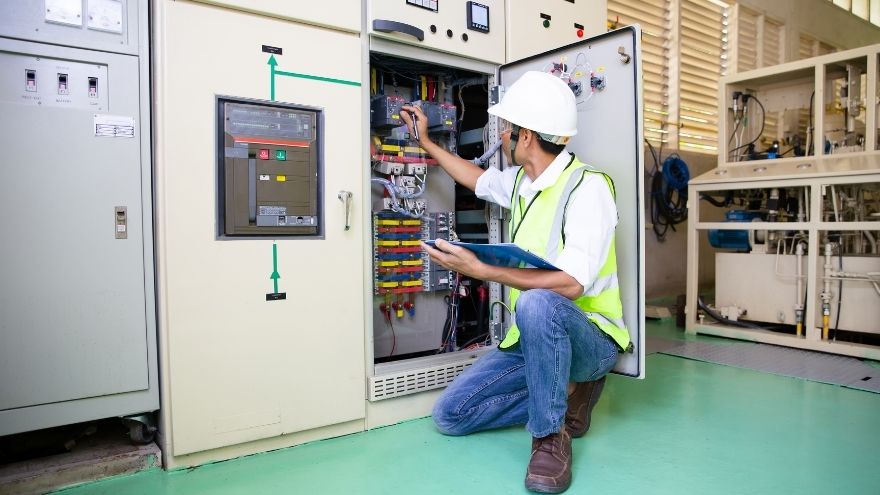Reactive power is a type of power in an electrical installation that moves between a power source and a load. Unlike active power, it does not perform actual work, but is necessary to properly power inductive or capacitive devices. In what situations is compensation needed at home? And how does it help reduce bills?

Check out the reactive power compensators at the Onninen wholesaler
When is reactive power compensation necessary at home?
In homes, reactive power compensation is not always necessary. If standard equipment, lighting, or electronics are used, the amount of reactive power generated is small, so there is no need to compensate it.
 The need for reactive power compensation in a home can be discussed in three cases. The first is when there are many inductive devices in the home. Examples include air conditioners, washing machines, refrigerators, pump motors or other high-power motors. During operation, the devices generate a large amount of inductive reactive power, which, if not properly reduced, will lead to energy losses and higher electricity bills.
The need for reactive power compensation in a home can be discussed in three cases. The first is when there are many inductive devices in the home. Examples include air conditioners, washing machines, refrigerators, pump motors or other high-power motors. During operation, the devices generate a large amount of inductive reactive power, which, if not properly reduced, will lead to energy losses and higher electricity bills.
Compensation at home is also necessary when using a photovoltaic installation. The problem increases in the case of large systems. Although modern solutions have the ability to reduce the amount of reactive power, over time this may prove to be insufficient.
Another situation where reactive power compensation is necessary at home is the use of industrial equipment, such as large compressors or lathes.
How to reduce bills with reactive power compensation in your company?
When running a business, an entrepreneur aims to optimize operations, reduce generated costs and increase profits. If a company has many devices that can increase power, then by compensating reactive power, energy bills can be reduced in real terms. The role of reactive power is to maintain the magnetic field, e.g. in engines and transformers. A large amount of generated reactive power adversely affects the transmission of energy, causing excessive load on the infrastructure used. Therefore, operators operating on the market charge companies additional fees for reactive power.
 In practice, inductive reactive energy can be balanced using available solutions. An example is reactive power capacitors , in which the essence of operation helps to balance the amount of capacitive reactive power. Compensation can take place in three variants, as individual, group or central compensation.
In practice, inductive reactive energy can be balanced using available solutions. An example is reactive power capacitors , in which the essence of operation helps to balance the amount of capacitive reactive power. Compensation can take place in three variants, as individual, group or central compensation.
Individual compensation is used for a single device, the reactive power receiver is installed directly next to the device. In the group variant, capacitors allow for taking over reactive power from a group of devices, while the most commonly used solution are central models, which are located at the main power supply point. Installation at a central point works especially well in those companies where high-power devices are used.
Reactive power compensators can be selected manually, although automatic control systems are increasingly being chosen, operating dynamically, adjusting the current condensation level to current needs. In order to reduce electricity costs, it is worth regularly conducting an energy audit and checking which of the devices used generate too much reactive power. If these are old devices, then it is worth considering replacing them with newer, more economical models. Currently, devices used in production processes or in companies in general are solutions in which the power factor is higher. In practice, this means that they can generate less reactive power. Additionally, limited reactive power consumption will help reduce energy losses that occur within the internal network. Replacement is the first step, it is necessary to monitor the effects of the implemented actions and, if necessary, modify and optimize them.
To what extent is compensation profitable for businesses and single-family homes?
In the case of single-family houses, reactive energy compensation is usually not used. The exceptions are houses in which, for example, a photovoltaic installation has been installed or many devices are used that lead to an increase in its value.
 The situation is completely different in the context of companies. Here, the use of transformers that allow for limiting the amount of reactive power is justified and, from the point of view of the costs generated by the activity, profitable.
The situation is completely different in the context of companies. Here, the use of transformers that allow for limiting the amount of reactive power is justified and, from the point of view of the costs generated by the activity, profitable.
Entities that generate a lot of reactive energy, such as manufacturing, industrial, commercial and service companies, seeking to reduce it, can install special receivers - capacitor banks. This involves an expense, but the cost of the investment, depending on the specifics of a given company, can pay off within a few months. In companies that generate less of this power, transformers can pay off even after a few years. When analyzing the benefits and risks, it is worth remembering that reactive energy not only causes higher bills, but also leads to excessive load on the wires in the internal networks of the plant.
Check out the reactive power compensators at the Onninen wholesaler